Threes in Charlotte: How the Hornets Have Revamped Their Offense
By Reinis Lacis (@LamarMatic)
Last year the Charlotte Hornets offense scored 97.6 points per 100 possessions (per NBA.com) which was the third worst mark in the league. The team’s starting line-up featured two players, Al Jefferson and Gerald Henderson, whose outdated games would have fit well in the 1980s, Kemba Walker and Cody Zeller who are worse at shooting the ball than the average player of their position and a person who is ignore-able outside the paint in Michael Kidd-Gilchrist.
It has been proven that there is correlation between successful three-point shooting and having a good offense. Five of the top-7 (Rockets, Cavaliers, Warriors, Clippers and Hawks) leaders in three-point attempts for the 2014-15 season reached the conference semi-finals. The Portland Trail Blazers, ranked third in this category, were a low-key Western contender which had its season ruined after Wesley Matthews tore his Achilles. (The Philadelphia 76ers were also a part of this top-7).
Chris Baker and Steve Shea did a fantastic job at mathematically proving that the more 3-point threats a team has out there, the less help defenders a team faces when penetrating. More long-range threats on the court also improve a team’s offensive rating.
Thus it is encouraging to see that the Charlotte Hornets have attempted 25.6 three-pointers per game during the 2015-16 preseason, which would have been good for the eighth most three-reliant team in the league last season (it’s safe to say though that the upward trajectory of more threes being taken league-wide will resume this year and that such a mark won’t land you in the top-10 this coming season). That number was at 19.1 last season. It is an improvement that had to be made for a flawed offensive team.
A stat that I have mentioned beforehand is the fact that not long ago our franchise record for threes taken in one game was almost 20 years old. On March 8th, 1996 Glen Rice and Larry Johnson combined for 19 three-point field goal attempts en route to a overtime loss at Orlando. The team’s overall 31 three-pointer attempts was a franchise record.
Only in the last week of the 2014-15 season the Charlotte Hornets team managed to break the record (32 attempts against Houston) and then settle one attempt above it (33 attempts in Toronto).
This preseason the team has managed to approach that record of ’96 two more times. These games point to a philosophical approach of paying more attention to that aspect of the game and, moreover, indicate how old-fashioned our offense has been these last few years, given the fact that the record was that old to begin with.
The offensive transformation has been visible when watching the offensive sets the Hornets have been using. The focus of putting our players in places from where they can spot up for threes is there. Here are a few of the ways the team has been doing that.
Having Guards Pop Out During a Pick-n-Roll
Rookie Frank Kaminsky has been popping out to the three-point line a whole lot. And that’s what you should do with a seven-footer who is such a gifted shooter and playmaker. When he sets the on-ball screen it usually turns into a pick-n-pop. When the other big is used for the pick-n-roll, Kaminsky will slide out from the paint to the three-point line to create space for the rim-runner by forcing his defender to either leave the paint or giving up an open three. This is normal, everyday NBA stuff (which we didn’t have the personnel to do last year):
What’s more fun and unique is that we have used our two-guards (Troy Daniels, P.J. Hairston, Jeremy Lamb and Aaron Harrison) in a similar manner.
They will go on to stand in the same position underneath the basket but first will set a screen on the big man’s defender on their way there (a detail that I very much like as it complicates the defense’s task of dealing with the pick-n-roll as you’re in a catch-up situation from the very start).
Here’s Daniels setting a screen on Spencer Hawes‘s man as Hawes is heading up to play the pick-n-roll:
Then as the pick-n-roll is set off Daniels sprints out behind the three-point line:
It not only puts a very good shooter in a comfortable spot but once again messes with the defender’s mind. Firstly, he has to wonder how to help-defend the two players involved in the pick-n-roll who are coming right at him. And, secondly, he all of the sudden has to leave the paint and ignore those two players to chase his own assignment. I bet that during the season some opponents will be caught asleep as they mismanage the situation and don’t chase out the shooter.
A play which I might like even more is sort of a reverse set when compared to the previous one.
In this case the shooter goes behind the pick-n-roll and sets a back-screen on the defender whose man is the pick-n-roll screen setter. Here’s an example of Aaron Harrison being ready to confuse rookie Myles Turner:
Then, just as in the previous case, he’ll pop out behind the three-point line.
The genius of this play is that pretty much forces the defense to make uncomfortable switches. If the screen hits the defending big man good enough to block his backwards movement, the ball handler is in a good spot to use that to his advantage and drive past him to the rim. Spain abused Lithuania with this play in the final of EuroBasket 2015 as Jonas Valanciunas was stopped in his tracks by the back-screen and his teammates weren’t ready to make the quick switch and prevent penetration.
In this case, Rodney Stuckey has the awareness to make the switch and step in front of Brian Roberts, the ball handler:
But that also leaves Myles Turner on Aaron Harrison, who has already visions of making a three-pointer in his mind as he looks for a spot behind the three-point line.
And that’s exactly what happens. Brian Roberts smartly tilts Turner his way and forces him to retreat to the paint just as Harrison lines up for the shot:
The Three Base-Line Screens
Another play we have relied on heavily to get in our offense is what I jot down in my ever-present game notes as the “Mo Play”. It appeared as a somewhat regular feature of our playbook last February when Mo Williams first tried on a Hornets jersey. At its basis it is a very simple set that consists of three base-line screens for a guard. When the first screen catches the designated defender by surprise, a lack of communication from the rest of the two can generate a quite good look at a corner three:
An opportunity to get free for a jumpshot is exactly the purpose with which our gatling gunners like Jeremy Lamb and Troy Daniels will mostly approach the play:
Though it isn’t all about taking a shot right off the bat. First off, this isn’t a play impossible to stop. The alignment of the three screeners makes for crowded space and the man guarding the last player to set a screen (in this case it is Nikola Mirotic) can somewhat easily out-stretch his arm and step out to prevent a direct pass to the corner:
However, it doesn’t necessarily need to be all about looks at threes. It can ultimately be used for a curl to the middle by a capable ball handler to force the defense to shift towards him. Ultimately, this was used as a way to get Mo Williams in motion for a pick-n-roll as well.
Expect Jeremy Lin and Nicolas Batum to be used in this play. It gives them the opportunity of driving to the middle with a decent array of options available for them. The set enables us to use our two ball-handler (consisting of at least two of Kemba Walker, Lin and Batum) line-ups more efficiently and put them in a position where both can work off each other.
Such changing of sides of the court is what our anemic offense desperately lacked last year. Just look how easier it is to enter the ball in the post to Al Jefferson (side-note – we seem to have added some plays centered around inserting the ball in the post to Al, will probably follow-up on this some time in the future) when we’ve got the attention of the defense on the other side of the court beforehand:
This is a much-needed breath of fresh air after forcing the same valiant Gerald Henderson cross-screen for Al a dozen times per game last season.
Constantly doing this is just too static and easy to predict. The set is a symbol of attempting to play in a 90s style when the defense is already in 2015. Such a way to insert the ball in the paint is dying out and rightfully so. It is too easy for defenses to crowd the paint and force our offense to struggle with getting Jefferson the ball.
The three-screens play shown previously or the following play (with Nicolas Batum in the role of a pop-out guard during a pick-n-roll) has the potential of a better success rate since the post-up is a by-product of a different set where player movement requires attention and you can’t focus all of your energy on preventing a Gerald Henderson cross-screen which everybody in the arena is anticipating:
The Pick-N-Roll/Frank Kaminsky Back-Screen
I already touched on this cool feature the last time I published my preseason observations. To recap, with Frank Kaminsky stationed underneath the basket we run a pick-n-roll. The second the ball handler drives past his pick, Kaminsky sprints to the corner through a screen set by the wing:
The power forward guarding him has to contemplate what to do about the seven-footer rolling to the front of the rim, the three-point threat who just left the premises to find an open look and why life is so hard in general. Additionally, if a wing wants to help out on Kaminsky he is likely to be held back by that screen.
P.J. Hairston demonstrated what might happen when a good defensive team takes such situations for granted and is capable of switching on-the-fly. This time we ran a very similar play, only with Kaminsky already behind the three-point line on the weak side. A back-screen was set on Kaminsky’s man (Taj Gibson) while the pick-n-roll was executed and Gibson seemingly has to find himself in the a fore-mentioned dilemma:
Following Frank and leaving his team to guard the pick-n-roll 2-on-2 wouldn’t be right. Yet the passing angle for Lin to find Frank the Tank is right there.
For a short time period it feels like Chicago is smart enough to make the switch in a fraction of a second by having Doug McDermott commit to Kaminsky. However, Hairston instantly pops out behind the three-point line himself catching the trained rim protector by surprise:
If the previous two examples were moreso side-actions we can also put Kaminsky on the strong side of the ball and go to him on purpose with the help of such a screen while a pick-n-roll is being run. On this play the pick-n-roll is only a mean through which we get the ball to Kaminsky:
Frank’s shooting is a huge weapon and it’s great to see that we’re adding small, off-ball sprinkles based on his talent around our main action to muck up the plans of defenses. Such plays have the potential of making the Hornets much more unpredictable on offense.
It goes back to what I had to say about last year’s team and how they were built overall:
This year we have said players with those certain skills at a good enough level.
The team’s front-court has undergone a defense-to-offense revamp by losing rim protector Bismack Biyombo and adding marksmen Kaminsky and Spencer Hawes. Meanwhile, Nicolas Batum and Jeremy Lin are above average at shooting threes (Batum’s last season notwithstanding) and passing the ball, while Gerald Henderson was mostly good at taking so many fade-away twos that both of his last two seasons qualified for the top20 of the aptly named PISS-Poor Shot Selection stat, created by the awesome Stephen Shea and Christopher Baker.
The bet that we’re making here is that our influx of offensive talent improves our offense more than the lost players meant for our defense. Unfortunately, the only problem at this point is that Michael Kidd-Gilchrist also is lost for this season. Without him this transaction looks much more uncertain. It’s up for coach Clifford to get the new players accustomed to his conservative defense so the drop-off there wouldn’t be much to steep.
Meanwhile, I would say that finishing 15th in offensive rating and being an average NBA scoring team would be a huge step in the right direction. The players and sets are certainly promising for us to produce a more watchable and contemporary offense. We’ll see whether that will also translate to much better production.
A couple of more observations I’ve had that I want to point out:
Switching on Defense
The Hornets under coach Clifford have almost exclusively followed the schemes of Tom Thibodeau. We “Ice” pick-n-rolls (deny the ball handler the middle on them), our centers (power forwards will step out, however) drop back when defending pick-n-rolls and we ultimately try to keep all action on the sides of the court.
However, I have noticed that our players have switched when defending some pick-n-rolls this preseason and have seemingly done by design. It mostly has come between the 3 and 4 position (Cody Zeller, Marvin Williams and Nicolas Batum have been used at this) and uses the versatility of, perhaps, our best defenders (sans MKG) in Zeller and Batum.
I can speculate that it has been influenced by the switching-heavy style of the Golden State Warriors and, namely, Draymond Green. Zeller is a darn good defender on the perimeter and by doing this we maximize his and Batum’s potential of disrupting offenses. Players capable of switching force opponents to go late in the shot clock as a successfully executed switch kills any advantage that a pick-n-roll might create.
In a way, this could also be a method to inject some kind of forcefulness to our predictable defense as we have lost our most unpredictable defender for the season.
Jeremy Lin Getting Back in the Play
You never know the tendencies and skills of other team players on defense as well as you do with the guys who you watch for 82 games a season. My viewpoint of Lin’s defense has been that his best attribute is being able to scramble back in the play after getting screened in the pick-n-roll.
In the game at Detroit he did a great job of doing just this and comforting me that there is a basis behind that opinion.
Lin made two great defensive plays down the stretch by catching up with Reggie Jackson and disrupting the play.
Good stuff. If this was a regular season game (and the rotations actually much more resembled one that in most cases) we would be talking about him sealing a victory for us.
I’m actually much more comfortable about Lin and Kemba playing together on defense than I am about their fit on offense. Lin’s big enough not to be over-powered by too many shooting guards and we can put Batum on the more dangerous wing either way.
Troy Daniels’s Defense Meanwhile..
..is bad. I’m talking about P.J. Hairston-bad.
Daniels got some decent burn during the preseason in Clifford’s quest of evaluating what exactly do we have in our poo-putt platter of two-guards. And while Troy has continued to prove (ever since him raining down three-pointers in the last games of the 2014-15 season) that he is a better shooter than Hairston, he suffers the same problems on the defensive end, what is something that I also sensed when writing his review after last season.
Daniels spaces out and loses his man off the ball. He tends not to be ready to defend pick-n-rolls. He unexpectedly gets hit by screens. He’s very, very bad at closing out on a shooter. It really is a collection of bad types of mistakes on defense:
Closing out on your defender with the foot which can deny the middle in front of you (in this case, his left foot) should be ingrained in the muscle memory of a professional player.
Some Line-Up Thoughts
There will be a Hornets-themed podcast next week and the guest is a very well informed person who might shed some light on the starting line-up with which are bound to start the season with. (You can also expect a NBA champion with the Lakers to be a guest on the podcast in the near future.)
However, at this point I have some random thoughts about the situation which might present itself if we don’t elect to pick a starting shooting guard and simply slide Batum down a position while playing Marvin Williams at the 3.
It creates a situation of Cody Zeller playing most of his minutes as the starting 4 alongside Al Jefferson. That also means that our back-up front-court duo is Spencer Hawes and Frank Kaminsky. I’m not all that sure how the two of them will fare defensively when played together. Playing Zeller some staggered minutes so he would be paired with one of them might be a good idea due to his athleticism. Because, in my opinion, Hawes and Kaminsky seriously lack it.
Only twice during Hawes’s career has his team secured the defensive glass better when he is on the court than when is off it. Both of those times it was a meager advantage of +0.3 in DefREB%.
In 2011-12 Philadelphia was at its worst at defensive rebounding whenever Hawes was on the court. In 2012-13 they rebounded the best when Hawes sat on the bench.
Under coach Clifford we have finished 1st both times in the league at DefREB%. It is a monument of his principals and helps us succeed as a defensive-minded team despite having some bad defenders amongst bigs. A Hawes/Kaminsky duo might have some shortcomings in this department (and on defense, overall).

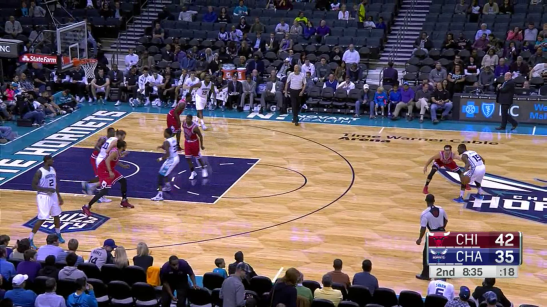

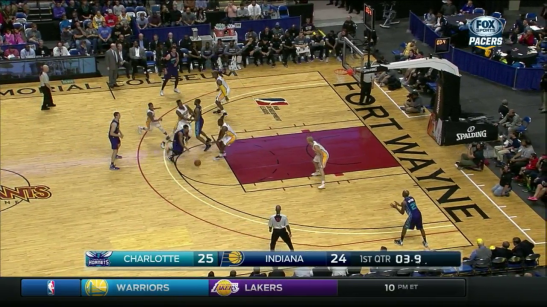
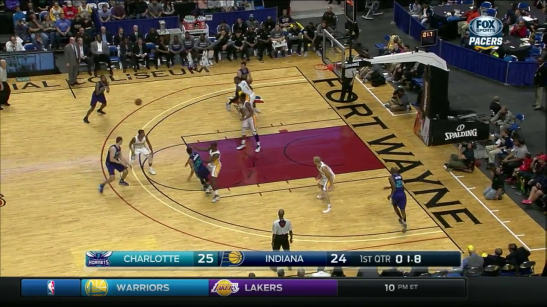

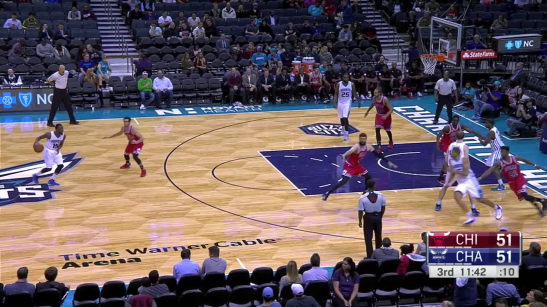
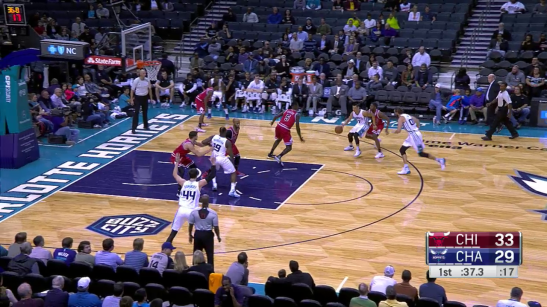
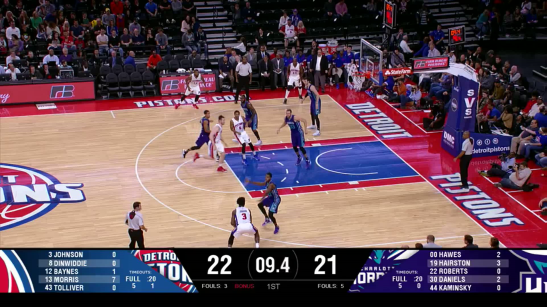
Some unanswered question remaining
Can Lamb play defense? he’s looked bad in one game, other’s not quiet sure.
Can anyone on this team actually roll with Lin? still not resolved, he found a lot of them anyway but no one been showing anything like a Ed Davis / Tyson Chandler of heck even Greg Smith 12-13.
I’d say generally the most impressive lineup was probably Kemba / Lin / Batum / Zeller / Hawes , that’s probably the best offensive lineup and close enough to the best defensive lineup, hard to know how much we’d see that in season though.
LikeLike
Pingback: Charlotte Hornets - Jeremy Lin Ready to Transform the Team's Offense | Sportige